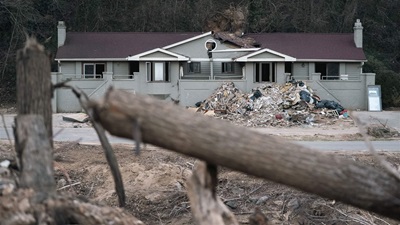States Look to Improve Disaster-Ready Budgeting Practices
At webinar, policymakers and experts share strategies for managing a growing financial risk

States face growing fiscal risks from a range of natural disasters, but policymakers can take steps to be better prepared for whatever comes their way. State leaders, policy experts, and emergency management professionals took part in a June 13 webinar exploring how states can strengthen their fiscal readiness amid growing costs and a shifting federal policy landscape.
Challenges of higher costs and future uncertainty
To start the session—cohosted by the Council of State Governments and The Pew Charitable Trusts—Trina Sheets, executive director of the National Emergency Management Association (NEMA), provided an overview of the current disaster management landscape. Disasters are becoming more frequent and severe, while the federal-state-local partnership is undergoing a major shift. Sheets referenced the potential elimination of the Federal Emergency Management Agency, cancellation of the Building Resilient Infrastructure Communities program, and proposed increases to the federal disaster declaration threshold—changes that could leave states with more responsibility for paying for activities before, during, and after disasters. For example, such expenses could include investing in mitigation practices, deploying first responders, and helping residents recover following extreme weather events.
She noted the continued importance of the Emergency Management Assistance Compact (EMAC), an interstate agreement managed by NEMA that allows states to provide each other with mutual aid. According to Sheets, interstate assistance through EMAC can be an efficient and cost-effective alternative to federal aid in some cases.
Proactive state budgeting can help
To better handle the impact of these changes on state budgets, Peter Muller, a senior officer at Pew, said that states need to adopt proactive, structured approaches to disaster budgeting. Drawing from recent Pew research, Muller outlined a three-part strategy: measure, manage, and mitigate.
- Measure. Tracking disaster-related spending across agencies and activities will allow states to more fully understand fiscal effects.
- Manage. Adequately and regularly funding dedicated disaster funds and other reserves is key to minimizing budgetary disruption.
- Mitigate. Investing in resilience and risk reduction—through both capital and operational budgets as well as by bolstering local capacity—can lower long-term costs.
Muller provided examples from states that have undertaken activities aligned with these three key principles, teeing up a more in-depth discussion of state practices from two state officials.
Case studies in disaster-ready budgeting
Massachusetts state Senator Jo Comerford (D) shared how back-to-back disasters in 2023 drove her and legislative colleagues to create a new statewide disaster account to help minimize the disruption that extreme weather events place on the state budget and provide timely aid to those in need. Legislators worked with Governor Maura Healey (D) to include nearly $15 million for a new Disaster Relief and Resiliency Fund in Healey's fiscal year 2025 budget. Now Comerford and fellow lawmakers are working to create a dedicated revenue source to ensure that the account remains consistently funded.
Minnesota has also made strides in providing more proactive and reliable funding for disasters. During the webinar, State Budget Director Ahna Minge described the Disaster Assistance Contingency Account, which has delivered funding for more than 80 disasters since 2014. The account provides predictable, timely support to local governments and is now funded by an automatic transfer mechanism from the state general fund, up to a $50 million balance. Minnesota is also investing heavily in climate resilience planning and infrastructure. These actions align with Pew’s disaster-ready budgeting principles and will help the state stay a step ahead of increasingly frequent and destructive disasters by helping leaders reduce and better manage long-term costs.
Looking ahead
The webinar concluded with a call for continued collaboration among states, greater transparency in disaster spending, and efforts to update funding mechanisms to ensure timely and predictable assistance for communities while minimizing budget stress. In the face of overlapping challenges, states have the opportunity to lead in building more resilient, fiscally sound approaches to how they deal with natural disasters.
Colin Foard directs The Pew Charitable Trusts’ managing fiscal risks project.










